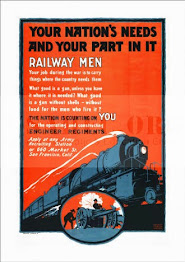From September 1941 and July 1942 the 711th Railway Operating Battalion with help from the 91st and 93rd Engineer Battalions, constructed a 47.66 mile railroad in Louisiana between the Missouri Pacific Railroad which served Camp Claiborne, LA and the Kansas City Southern Railway that served Camp Polk, LA. Known as the Claiborne – Polk Military Railway (C&P) it became the primary Army owned and operated facility for “technical” training of Military Railway Service (MRS) units. Informally known as the Crime and Punishment, the line afforded the Army total flexibility for tactical training in basic railroad operations. Ultimately, a total of six Railway Operating Battalions (ROB) and the two Railway Shop Battalions (RSB) would conduct technical training on the C&P. Units training on the C&P included the 711th ROB (Training Battalion), 712th ROB (RDG & CNJ), 714th ROB (Omaha Road), 718th ROB (NYC), 725th ROB (C,RI,&P), and the 752nd ROB (B&M). Also, training on the C&P were the 760th RSB ( ? ) & 762 RSB (Alco), the MRS’ two diesel shop battalions. Five additional battalions, the 715th ROB (IC), 719th ROB (T&NO), 759th ROB (MP), 754th RSB (SP), and 755th RSB (N&W) were activated and conducted basic training at Camp Claiborne but transferred to commercial training facilities for technical training.
Returning from service on the Alaska RR in May 1945, the 714th ROB became the last rail unit assigned to Camp Claiborne. With victory in the Pacific on August 15, 1945, neither Camp Claiborne nor the C&P were part of the Army’s long term post war stationing plan. Both Camp Claiborne and the C&P were declared excess and dismantled in short order. In January 1946 the 714th ROB would move it’s flag to Fort Eustis, VA, where, other then being deployed to support actions in Korea, it would call home until deactivated on June 19, 1972.
Today Camp Claiborne is a forest of mature trees interlaced with decaying roads and building foundations. While a short segment of the C&P continues in service at Fort Polk, the balance of the right of way is trackless but with use of topographic map and back roads can be located at many locations. Still inscribed in the Camp Claiborne enginehouse foundation are the initials C, RI, & P RR from the 725th ROB. Otherwise with the exception of a plaque by the still existing main gate, little marks the existence of this once thriving military base and even less of the C&P training railroad.
In an effort to correct this neglect of history, the Southern Forest Heritage Museum of Long Leaf, LA will be holding its first annual Camp Claiborne-Claiborne and Polk Military Railway Symposium this coming October 29th and 30th. The symposium will feature both formal presentations as well as on the ground explorations of the facilities and rail right of way that once existed. Additional details at http:www.foresteritagemuseum.org/ or from LT. Melinda West at Melinda.West@Isus.edu.
While the C&P provided an excellent training facility, a greater number of MRS units conducted their technical training on commercial railroads based on agreements between the Army and the individual carriers. Overall, 30 of the 36 ROB’s and 10 of the 12 RSB’s activated in CONUS would conduct their “technical” training at 12 commercial rail facilities. The earliest of these commercial arrangements beginning in March 1942 was the 727th ROB which was mobilized and assigned to Camp Shelby, MS, near Hattiesburg, MS. The 727th conducted training on the Southern Railway’s New Orleans and Northeastern Railroad (NO&NE) between New Orleans, LA, and Meridian, MS. While the battalion was assigned to Camp Shelby, “C” company, battalion train operations, was billeted at the Hattiesburg passenger station (Fort Northeastern) aboard NO&NE furnished passenger and camp cars. “B” company, battalion maintenance, trained at the NO&NE shops at Meridian, MS and was billeted at nearby Key Army Air Field. This basic concept served as a template for other ROB training complexes. Successor of the Southern Railways NO&NE is the Norfolk Southern Railway.
LTC Mark Metz
 Henry “Hank” J. Swalley, 82, a resident of Willow Gardens, died Wednesday, Jan. 26, 2011, at St. Luke’s Hospital in Cedar Rapids following an extended illness. Funeral services: 10:30 a.m. Saturday, Jan. 29, at Murdoch Funeral Home & Cremation Center in Marion, by the Rev. Michael Kleeberger. Family will greet friends from 4 to 7 p.m. today at the funeral home. Burial: Cedar Memorial Park Cemetery, Cedar Rapids. Military honors: Marion American Legion Post 298.
Henry “Hank” J. Swalley, 82, a resident of Willow Gardens, died Wednesday, Jan. 26, 2011, at St. Luke’s Hospital in Cedar Rapids following an extended illness. Funeral services: 10:30 a.m. Saturday, Jan. 29, at Murdoch Funeral Home & Cremation Center in Marion, by the Rev. Michael Kleeberger. Family will greet friends from 4 to 7 p.m. today at the funeral home. Burial: Cedar Memorial Park Cemetery, Cedar Rapids. Military honors: Marion American Legion Post 298.




